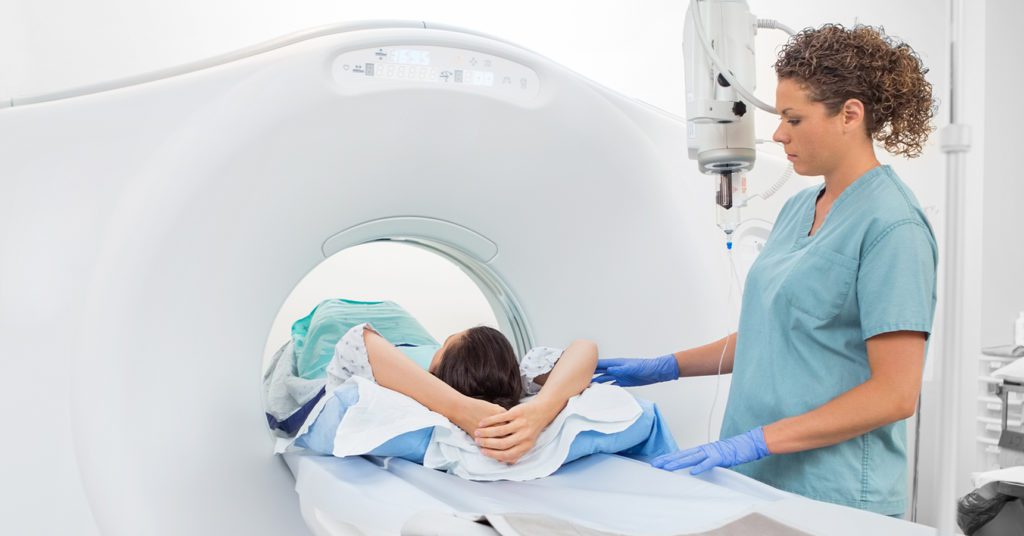Your healthcare provider recommended a chest CT scan because it is a highly effective tool for the early detection of lung cancer, which leads to 20% of cancer deaths, both in people who smoke and for people who do not smoke.
Early detection is important because it significantly increases the chances of successful treatment, and can lead to improved health outcomes. That’s what makes chest CT scans such a powerful tool for fighting lung cancer.
In this guide, we’ll show you how a CT scan helps early detection, what lung cancer looks like on CT results, and how you can get ready for your chest CT scan.
How does a chest CT scan work?
A chest CT scan creates detailed images of your chest by using a series of X-ray beams and computer processing. As the machine takes X-rays from different angles around your body, the computer combines these images to form a cross-sectional view, which look sort of like thin slices. The computer then puts these slices together to create a comprehensive and detailed picture of your lungs and surrounding structures.
What can a CT scan of my chest show?
A CT scan of your chest can provide detailed images of your lungs, airways, blood vessels, lymph nodes, and other structures. This level of detail can help your healthcare provider identify early signs of lung cancer, like small lung nodules or abnormal growths that might not be visible using other methods. CT scans can also reveal other potential issues, like infections, inflammations, or other chest and lung conditions that might require medical care.
Detecting lung cancer with a chest CT scan
A chest CT scan is one of the most reliable ways to detect if someone has lung cancer. A specific type of chest CT scan called a Low Dose Lung Screening CT, provides a minimal radiation CT scan to detect and monitor lung nodules to determine presence of lung cancer.
Let’s find out why early detection is important, what makes CT scans so good at detecting cancer, and how they work to find cancer early.
Why is it important to find lung cancer early?
Finding lung cancer early is important because it greatly increases the chances of successful treatment. When lung cancer is detected at an early stage, it is often more localized, and has not likely spread to other parts of the body. This means that treatment options, like surgery or targeted therapies, can be more effective. Early detection can also help you avoid more invasive treatments, and can improve overall survival rates, giving you a better quality of life.
What makes a chest CT scan effective for detecting lung cancer early?
A chest CT scan is particularly effective for detecting lung cancer early because it provides highly detailed images of your lungs. This level of detail allows doctors to see very small nodules or other irregularities that might not be visible with other imaging techniques. When your provider is able to see these small changes early, it means that lung cancer can be identified before it grows or spreads, allowing for prompt and more effective treatment.
How can chest CT scan images show the early signs of lung cancer?
By examining the size, shape, and density of any lung nodules, healthcare providers can determine whether the nodules are likely to be cancerous. A CT scan can also detect changes in the lungs’ structure and tissue, giving your provider critical information that helps in the early diagnosis and management of lung cancer.

Identifying the early signs of lung cancer on a chest CT
Your healthcare team will study your chest CT results for any signs of lung cancer, using their training and expertise to help diagnose your condition. In this section, we’ll let you know about the early signs of lung cancer on a chest CT, including lung nodules and other growths.
What types of lung abnormalities can indicate early-stage lung cancer?
Early-stage lung cancer often presents itself through small, subtle changes that might be hard to notice without advanced imaging. Some common types of abnormalities that can indicate early lung cancer include tiny nodules, irregular growths, and areas of unusual density in the lung tissue. These changes can be so minor that they don’t cause any symptoms, making a CT scan vital for early detection.
How can a chest CT scan detect nodules and growths in the lungs?
A chest CT scan is particularly adept at detecting nodules and growths because it creates detailed cross-sectional images of the lungs. This imaging technique allows healthcare providers to examine the lungs in thin slices, making it easier to spot even very small nodules. The high resolution of these images provides a clear view of the lungs’ structure, enabling doctors to identify and monitor any growths.
What specific features on a chest CT scan are characteristic of early-stage lung cancer?
There are several features that healthcare providers look for as signs of early-stage lung cancer, including nodules with irregular or spiculated edges, which can indicate a more aggressive growth pattern. The density and size of the nodules are also important, since typically, nodules that are denser and larger are more likely to be cancerous. Your provider will also look for the presence of hazy areas on the scan, which could be a sign of early lung cancer.
What qualifies for a Low Dose Lung Screening CT or a Chest CT scan?
The low dose lung cancer screening CT is performed when a patient meets the following criteria:
- Asymptomatic – no signs or symptoms of lung
- Age 50-77
- You’re either a current smoker or you quit smoking within the last 15 years.
- You have a tobacco smoking history of at least 20 “pack years” (an average of one pack (20 cigarettes) per day for 20 years).
If you fall outside of the above criteria, your healthcare provider may order a chest CT instead to evaluate your lung health or symptoms.
What to expect during and after your chest CT scan
Looking ahead to your CT scan for lung cancer, there are a few things to keep in mind before and after your appointment. In this section, we will look at how to get ready, at what happens during a CT scan, and at what you can expect from your results.
How should I prepare for a chest CT scan?
Every CT scan is different, so be sure to follow your provider’s instructions for your appointment. Before your CT scan, you may be asked to avoid eating or drinking for a few hours before the scan. It’s important to wear comfortable clothing and to remove any metal objects, such as jewelry or eyeglasses, since these can interfere with the imaging process.
What should I expect during a CT scan for lung cancer?
During the scan, you will lie on a comfortable, padded table that slides into the CT machine. The machine is a large, doughnut-shaped device that will take detailed images of your lungs as you hold your breath for a few seconds at a time, which helps to get the clearest images possible. The scan is painless and typically takes about 10-30 minutes. Your technologist will be able to communicate with you throughout the process, ensuring that you are comfortable and informed, every step of the way.
How long will it take to receive my CT results?
After your chest CT scan, a radiologist will review your images, and send a report of their findings to your healthcare provider. The time it takes to receive your results can vary, but it usually takes about a week. Your healthcare provider will discuss your CT results with you, and explain what they mean in terms of your health. They will also go over your next steps, whether that involves further imaging, or a treatment plan.
How to schedule your MRI appointment with us
Touchstone Medical Imaging offers CT scans in Arkansas, Colorado, Florida, Montana, Oklahoma, and Texas.
Reach out to us at Touchstone, and we’ll help you schedule a CT scan appointment at an imaging center near you, today.
We’re here to help you get the answers you need.

Frequently Asked Questions (FAQ)
Your healthcare provider ordered a chest CT scan to detect lung cancer early, as a CT scan can reveal abnormalities before any symptoms develop.
A chest CT scan uses X-ray technology and computer processing to create detailed cross-sectional images of your lungs.
A CT scan of your chest can reveal detailed information about lung tissue, identifying potential tumors, nodules, and other abnormalities.
Early detection of lung cancer significantly increases the chances of successful treatment and can improve outcomes.
Chest CT scans are highly sensitive, and can detect small lung nodules and abnormalities that might not be visible on standard X-rays.
Chest CT scans can highlight small nodules, irregular growths, and other changes in lung tissue that may indicate early-stage lung cancer.
During a CT scan for lung cancer, you will lie still on a table while the scanner rotates around you, capturing detailed images of your chest.
It typically takes about a week to receive your CT scan results, after which your provider will discuss the findings with you.

